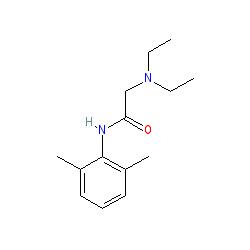|
Synonyms: Xylocaine®
lidocaine is an approved drug (FDA (1948))
Compound class:
Synthetic organic
Comment: Lidocaine was the first-in-class amino amide-type local anesthetic to be discovered.
Ligand Activity Visualisation ChartsThese are box plot that provide a unique visualisation, summarising all the activity data for a ligand taken from ChEMBL and GtoPdb across multiple targets and species. Click on a plot to see the median, interquartile range, low and high data points. A value of zero indicates that no data are available. A separate chart is created for each target, and where possible the algorithm tries to merge ChEMBL and GtoPdb targets by matching them on name and UniProt accession, for each available species. However, please note that inconsistency in naming of targets may lead to data for the same target being reported across multiple charts. ✖
View more information in the IUPHAR Pharmacology Education Project: lidocaine |
|
|||||||||||||||||||||||||||||||||||
| No information available. |
Summary of Clinical Use  |
| Used in the production of local and regional anaesthesia by injection and is also an active ingredient in a number of over-the-counter formulations for pain relief via topical application. In Europe marketing authorisation was granted in 2013 for Fortacin® a fixed-dose combination of lidocaine and prilocaine, as a treatment for primary premature ejaculation (physiological sexual dysfunction). |
External links  |
|
For extended ADME data see the following: Electronic Medicines Compendium (eMC) Drugs.com European Medicines Agency (EMA) |








